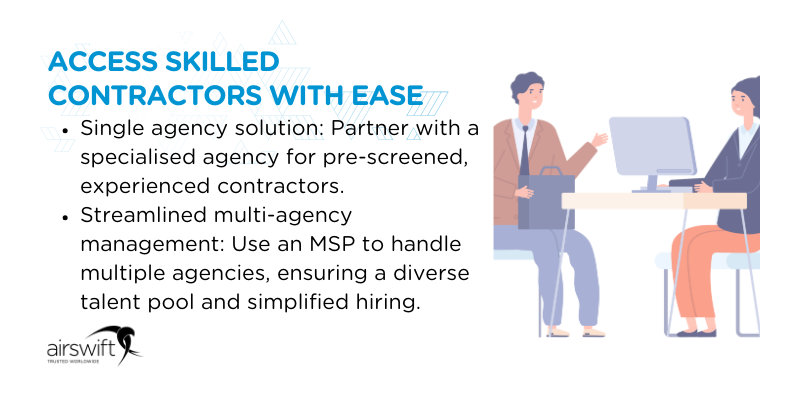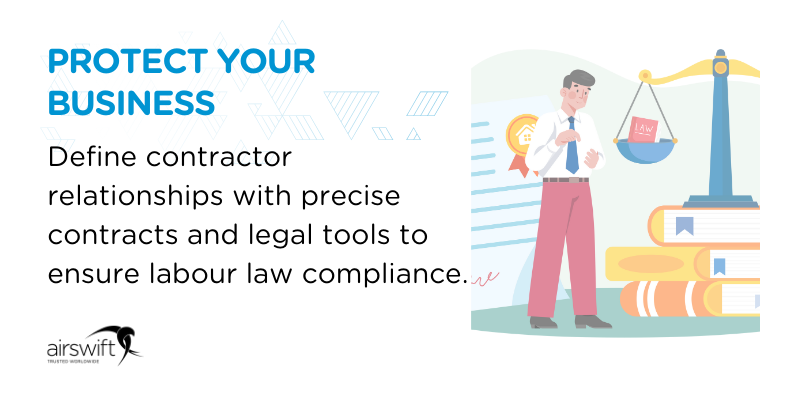
By
Diyaa Mani
April 15, 2025
Updated
April 15, 2025
Hiring contract employees has become a smart strategy for businesses seeking flexibility and access to specialised skills.
Contractors bring fresh expertise and help companies adapt to fluctuating workloads or short-term projects without the long-term commitments tied to full-time employees. This approach gives businesses significant cost savings on benefits, office space, and employment taxes while maintaining agility in a rapidly changing market.
However, working with contractors isn’t without its challenges. Finding highly qualified talent can be competitive, and ensuring legal compliance—such as avoiding worker misclassification—requires careful attention. Businesses must strike a balance between reaping the benefits of contractor flexibility and addressing these hurdles to ensure project success and operational efficiency.
Below are five common challenges companies face when hiring contractors and potential solutions.
Finding qualified contractors

Finding skilled contractors can be challenging. Unlike hiring employees, it's not as simple as reading a resume. Contractor qualifications aren't always presented in a standard format, and finding a good talent pool can be challenging.
Tapping into a specialised contingent workforce is an excellent solution for accessing skilled labour. You have two practical options:
- Single specialised agency: Consider working with a single agency specialising in contractors. This approach allows you to leverage their expertise in pre-screening and recruiting experienced contractors.
- Multi-agency management through an MSP: If you are working with multiple agencies, using a specialist Managed Service Provider (MSP) can streamline your process. An MSP can manage various agencies, ensuring that you get access to a diverse pool of skilled contractors while simplifying the hiring process.
This approach helps ensure you efficiently get the right talent for your projects.
For instance, if a company needs skilled electricians for a large commercial project, it partners with a contingent workforce agency specialising in pre-screened contractors instead of directly hiring. This ensured access to highly skilled electricians who completed the project efficiently and on time, avoiding delays caused by unqualified hires.
Ensuring compliance with labour laws

One of the biggest worries when working with contractors is ensuring you follow all the labour laws. Mishandling and treating a contractor like an employee can violate contract terms and lead to serious legal trouble and costly fines.
The key is to be crystal clear about the contractor relationship. This means having well-defined contracts that spell everything out as a form of legal protection. It's also a good idea to use assessment tools, such as independent contractor classification tools, employee misclassification analysers, compliance guides, and legal resource toolkits that help ensure accurate classification and compliance with labour laws to double-check that you've classified everyone correctly.
For example, if a company hires a contractor but fails to clearly define the contract's relationship, the contractor later claims employee status. This leads to legal scrutiny and fines for misclassification. Companies should use compliance tools to prevent this and draft explicit contracts outlining the contractor's role and responsibilities.
Managing project scope and communication
When working with contractors, especially remote ones, it's important to keep everyone on the same page. That means having a clear idea of the project and ensuring everyone talks to each other regularly.
Use strong project management tools, like Asana or Notion, to help organise tasks, deadlines, and responsibilities. Also, schedule regular check-ins—quick video calls or progress reports—to ensure everyone is aligned with the project's goals and that things are progressing as planned. This keeps projects running smoothly and guarantees excellent results.
Onboarding and integration
One big challenge for contractors is that they might not be as familiar with your company's culture or how you do things. Unlike regular employees, they jump in for a specific project and might need extra help getting started.
For instance, providing a detailed onboarding packet, including company policies, safety protocols, and training videos on sustainable practices, is just one example of best practices for onboarding new contractors. This streamlined integration allows contractors to adapt quickly and contribute effectively.
Creating a standard, quick onboarding process for all your contractors is smart. This should include an overview of your company's key policies and how things work. Also, ensure they have easy access to any necessary training materials for successful project completion. A good onboarding experience helps contractors integrate into your team quickly and deliver their best work.
Maintaining long-term relationships

Finding great contractors is one thing, but keeping them can be challenging, especially with so many options in the gig economy. To hold onto your top talent, focus on building strong relationships.
This means being open and honest in your communication, offering competitive wages that reflect their skills and experience, and looking for opportunities to work with them on future projects. When contractors feel valued and see a path for ongoing career development opportunities, they're likelier to stick around.
For instance, if a company worked with a freelancer who delivered exceptional results, it would offer competitive pay, consistent communication, and opportunities for creative input to retain them for future projects. This approach fosters loyalty, ensuring the freelancer prioritises their projects over other offers.
Boost efficiency and collaboration with contractor management
Hiring contractors comes with great perks—like tapping into specialised skills and cutting costs—but it also comes with challenges. The key is knowing how to manage those challenges effectively. With the right approach, businesses can create a smooth, productive working relationship that benefits both the company and the contractors. Getting this right isn’t just smart—it’s essential for staying competitive and adaptable in today’s fast-moving market.
Want to optimise your contractor management process? Contact Airswift today to discover how our tailored workforce solutions can help you build a successful, agile workforce and achieve your business goals.
